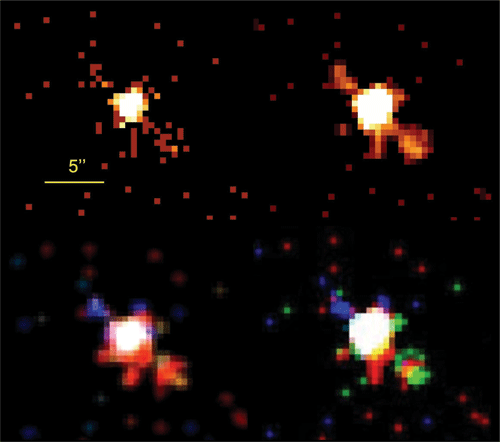Highlights - Volume 478-3 (February II 2008)
- Details
- Published on 24 January 2008
| HIGHLIGHTS: this week in A&A |
Volume 478-3 (February II 2008)
|
In section 6. Interstellar and circumstellar matter
“Discovery of a bipolar X-ray jet from the T Tauri star DG Tauri”, by M. Güdel, S.L. Skinner, M. Audard, K.R. Briggs, S. Cabrit, A&A 478, p. 797 The authors have detected an X-ray jet emanating from the young stellar object DG Tauri at a position angle of PA ≈ 225 deg, coincident with the optical jet axis, and also identified a counter jet at PA = 45 deg. The jet spectra are soft and there is evidence of excess absorption by the counter jet. The X-ray spectrum of DG Tau itself shows two components with largely different temperatures and absorption column densities. The similar temperatures and small absorbing gas columns of the jet sources and the soft component of the stellar source suggest that these sources are related, produced either by shocks or by magnetic heating in the jets, while the hard stellar component is associated with a stellar corona or magnetosphere. |
|
| In section 10. Planets and planetary systems
“Building giant-planet cores at a planet trap”, by A. Morbidelli, A. Crida, F. Masset, and R.P. Nelson, A&A 478, p. 929 This paper considers the interesting alternative possibility of planetary growth at the transition region between active (i.e. turbulent) and non-active parts of an accretion disk. At these locations, a positive density gradient is established at which the inward migration of planetary cores is halted (a so-called planet trap). The paper deals with the outcome of the interaction of several embryos at this trap, showing that systems with two embryos tend to acquire stable, separated, and non-migrating orbits, with the more massive embryo placed at the planet trap and the lighter one farther out in the disk, while systems of multiple embryos are intrinsically unstable. |
| In section 13. Astronomical instrumentation
“A robust morphological classification of high-redshift galaxies using support vector machines on seeing limited images.I. Method description”, by M. Huertas-Company, D. Rouan, L. Tasca, G. Soucail, and O. Le Fèvre, A&A 478, p. 971 Galaxy morphology is the most accessible tracer of the galaxies' physical structures. In recent years, algorithms have been developed to quantify that information and isolate it from spatial resolution effects. Those methods are, however, limited to 2 or 3 parameters per image and therefore only extract part of the information in these images. The manuscript generalizes those methods to include an arbitrary number of parameters and demonstrates a large improvement in classification efficiency for a deep seeing-limited dataset. |
© Astronomy & Astrophysics 2008


